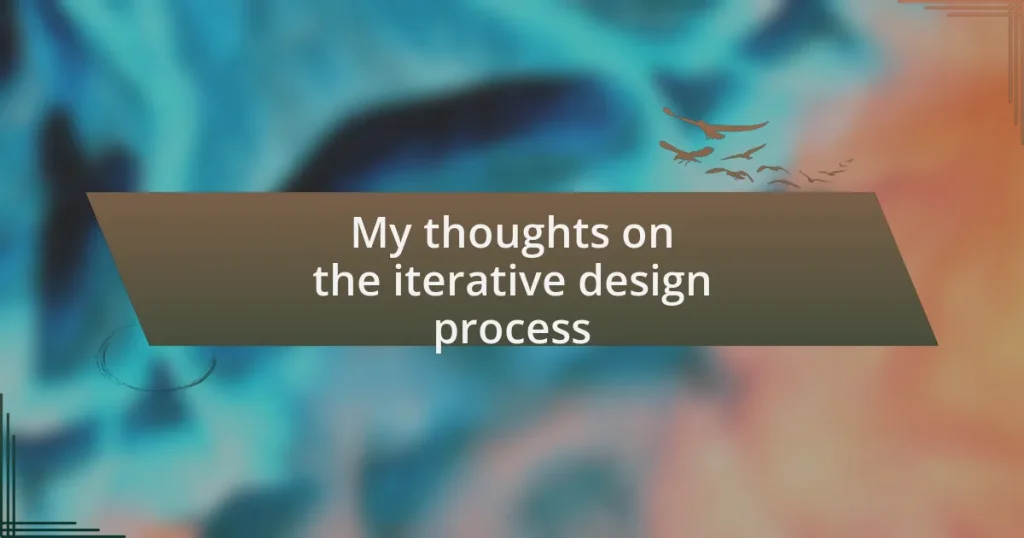Key takeaways:
- The iterative design process allows for continuous improvement through feedback, turning initial failures into learning opportunities.
- Benefits include fostering user-centered thinking, reducing risks and costs, and witnessing design progression through multiple iterations.
- Challenges involve stakeholder resistance, managing time effectively during iterations, and coping with critical feedback while maintaining resilience.
Understanding iterative design process
The iterative design process is a cyclical method that allows designers to continually refine their work based on feedback. I remember my first project using this approach; after initial testing, the feedback pointed out some usability issues I hadn’t anticipated. It was humbling but ultimately rewarding to see how small adjustments drastically improved the user experience.
What I find fascinating is how this process can turn initial failures into fantastic opportunities for learning. Have you ever launched something, only to find it didn’t quite hit the mark? That’s where the iterative design shines—by encouraging rapid prototyping and testing, we can understand user needs more profoundly and pivot our designs accordingly.
When I embrace the iterative process, I often feel a mix of excitement and apprehension. Each iteration is like a mini-journey, revealing new insights. It reminds me that design is not just about aesthetics but about creating solutions that resonate emotionally with users. This ongoing feedback loop helps me evolve not only my projects but also my skills as a designer.
Benefits of using iterative design
When I think about the benefits of using iterative design, one of the most significant is how it promotes user-centered thinking. Each round of feedback brings me closer to understanding what the users truly want, which is vital in creating effective designs. Have you ever put something out there, only to realize it didn’t resonate? I once developed a web feature that I thought was genius, yet user testing revealed it confused more than it helped. By iterating, I could refine it until it truly added value.
Another advantage I cherish is the ability to reduce risks and costs. With each iteration, I identify potential issues early in the design process. This means less rework and, ultimately, a more polished final product. I recall a project where early prototypes highlighted a navigation flaw that could have derailed the entire launch. Catching that in the testing phase saved both time and resources, allowing us to focus on refining the user journey instead.
Lastly, there’s something deeply satisfying about witnessing progression in design through iteration. Each version feels like a step closer to the well-crafted solution I envision. I remember comparing the first mock-up to the final product; the transformation was striking. It’s a testament to how embracing feedback fosters not only design improvement but also personal growth as a designer, nurturing a mindset of continuous learning.
Challenges in adopting iterative design
Adopting iterative design certainly comes with its hurdles. One challenge I’ve faced is the pushback from stakeholders who are accustomed to more traditional design processes. There was a time when a client was skeptical about the need for multiple rounds of testing, thinking it could delay delivery. Convincing them to invest time in iterations required me to show tangible results from previous projects, which was a pivotal moment in building trust.
Another obstacle is managing time effectively during iterations. I often find myself caught in the whirlwind of gathering feedback while simultaneously refining designs. It can be overwhelming. I remember a project where shifting feedback led to a chaotic schedule. I learned the importance of setting clear deadlines for feedback rather than letting it spiral out of control. But how do you balance all that? By prioritizing key feedback and knowing when to say enough is enough, I’ve found a way to streamline the process without sacrificing quality.
Lastly, there’s the emotional rollercoaster of receiving sometimes harsh criticism on your work. It can be challenging to separate personal investment from professional feedback. I still recall a moment when I thought I’d nailed a design, only to have peers tear it apart in a review session. That sting taught me resilience and the valuable lesson that iteration isn’t just about fixing flaws; it’s about growth. Embracing that feedback has ultimately made my designs stronger. How do you handle moments like that? For me, it’s about recognizing that each critique is a stepping stone toward something better.
